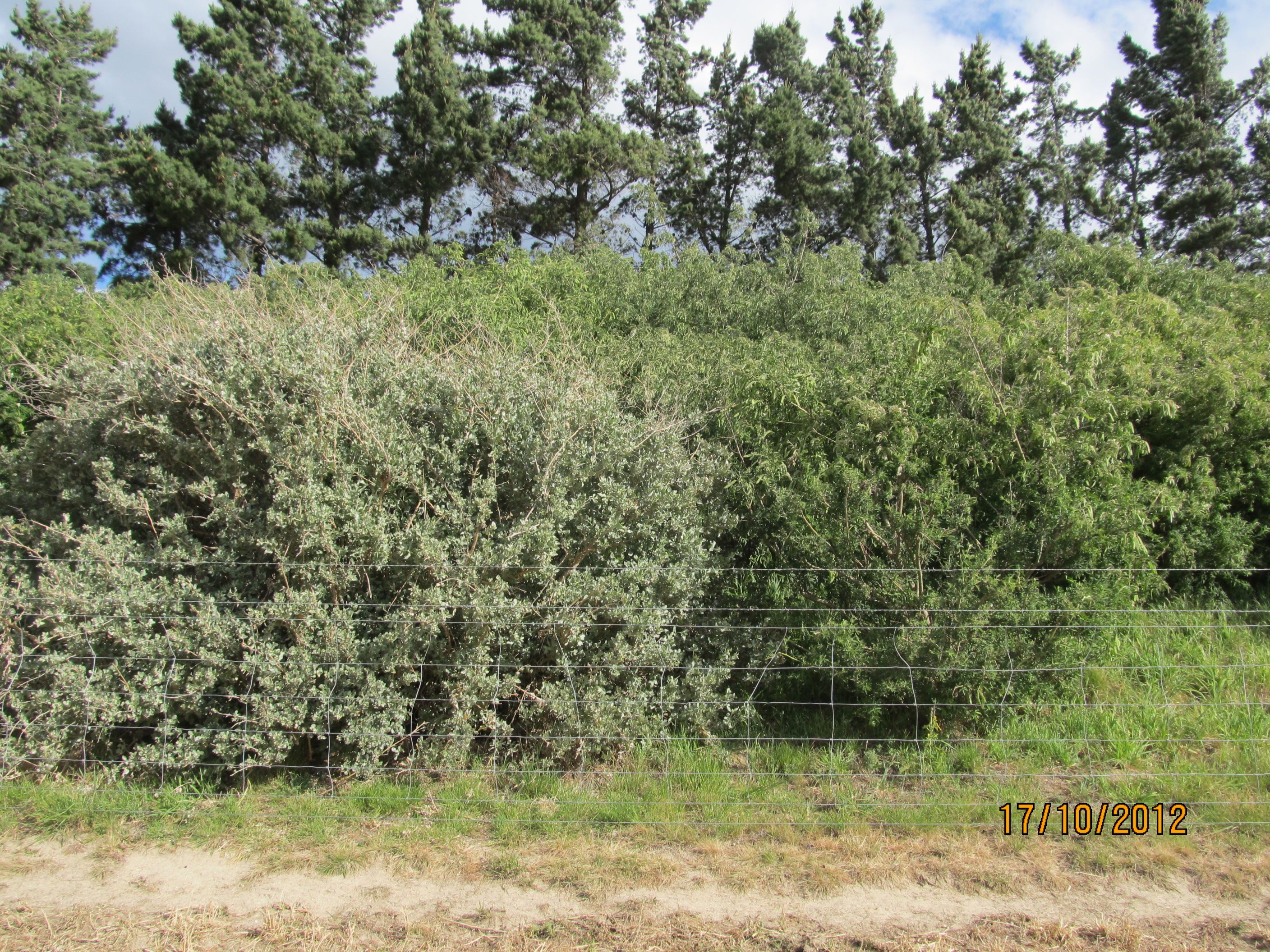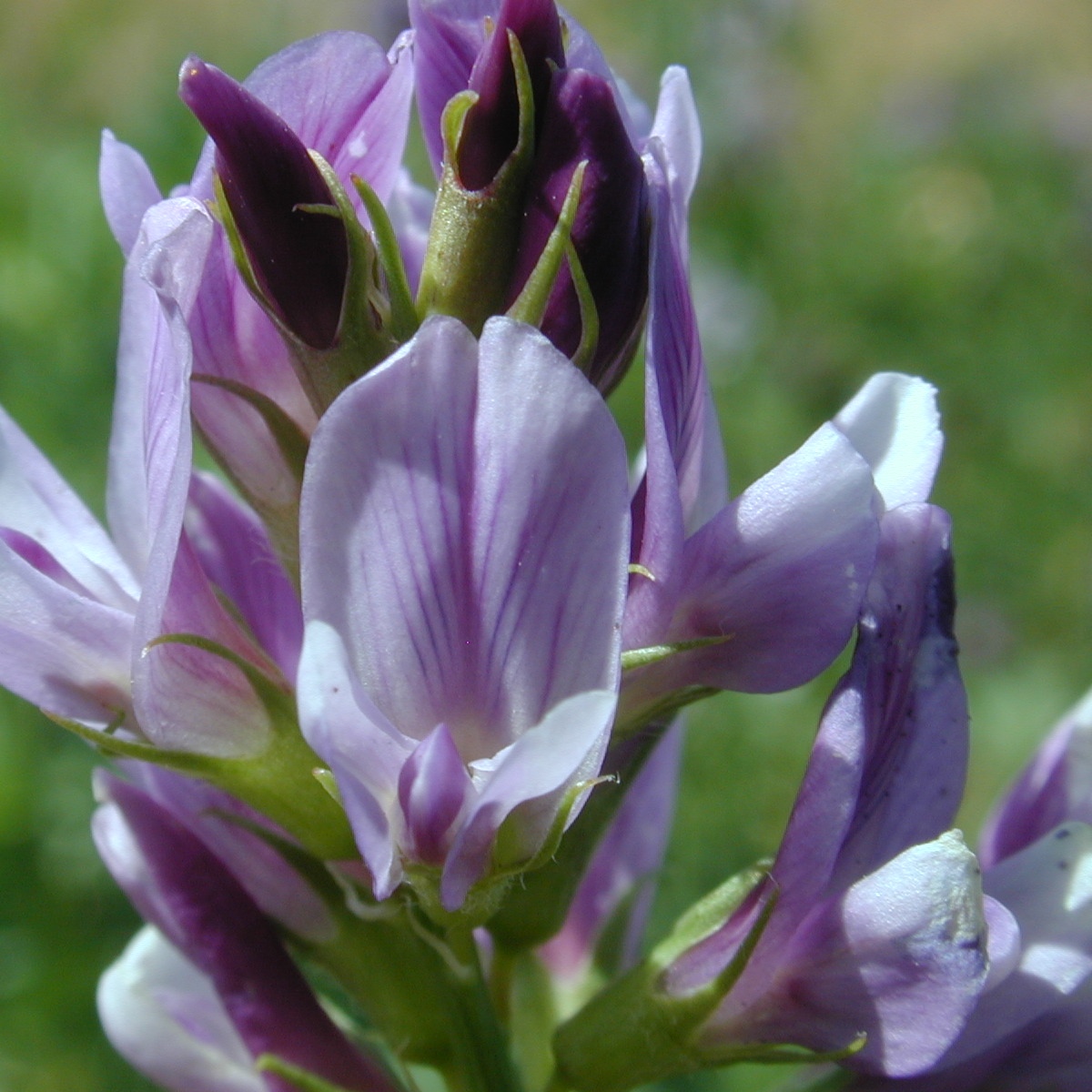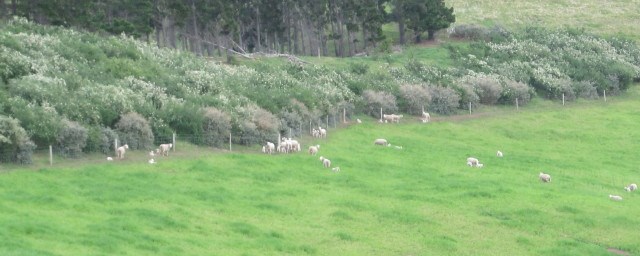The role of Bumble bees at Bonavaree is an important one. Short tongued bumble bees (Bombus terrestris) are the principle pollinator of Lucerne. There are other bee and insect species capable of pollinating the lucerne flower, but bumble bees are the most successful. The lucerne flower produces a tripping mechanism when an insect is pollinating the flower, honey bees tend to avoid lucerne flowers because it knocks them around too much. The bumble bee however is larger and more robust, so is better able to stand the tripping of the flowers when they are foraging.
In order to encourage bumble bees to an area you must provide the following: a habitat to nest and year round food. At Bonavaree, Doug and Fraser have made a concerted effort to provide areas on the farm that are conducive to sustaining a large and stable population of Bumble bees:
Sheltered paddocks:
Bumble bees are not particularly aerodynamic flyers, i.e. they are large, round and covered in fuzz. So by increasing planted shelter around paddocks, you are theoretically increasing the time spent by bumble bees foraging due to a reduced wind run, and in doing so you are also increasing pollination and potential seed yields.
Bumble bees are better able than honey bees at thermo-regulating their body temperature by contracting their internal flight muscles, along with their hairy body covering (which provides insulation), they are therefore better able to withstand cool weather conditions and forage for longer periods than honey bees can, i.e. earlier in the morning and later into the evening. Sheltered paddocks are usually warmer paddocks; this produces more favourable foraging conditions for all pollinators in cool conditions. At Bonavaree there has been large efforts made to provide shelter for livestock, but also to retain favourable conditions for bumble bee flight and pollination.
The photo below is taken of the North Face paddock in August last year. You can see the planting of Tagasaste (Tree Lucerne) and Salt bush, and also note the lambing hoggets who are making full use of the shelter. This extended “shelter belt” is on the leeward side of a mature row of pine trees. Underplanting mature shelter belts like this with another species provides effective shelter, by filling in the gaps between the trunks of the mature pine trees above. This area is also utilised as a space that is able to be periodically grazed. It is particularly valuable when used as shelter for triplet lambing mobs during harsh weather conditions. Both the salt bush and tree lucerne are fodder trees/bushes, and provide a source of good quality stock feed when required. The pasture grown underneath the bushes is kept under control by periodically grazing the area, which also improves pasture quality. Doug has also seen an improvement in the soil condition under the Tagasaste and salt bush, with a visible increase in humus and organic matter (a valuable increase in fertility of the clay based soils in this area).
 This planted area of Tagasaste (right) is replicated throughout the farm, along with many new native plantings, conserved wetland areas, and significant expanses of mature native bush which have been fenced off from stock over a number of years. The land located in these areas are significant habitats for bumble bees (along with numerous other species of beneficial insects and bird species) and are valuable assets for nurturing bumble bee nesting sites. Bumblebees are what are called “central place foragers” the central place being the nest. They fly out to the source of nectar/pollen then fly back, therefore the closer the nest sites are to your crop the better.
This planted area of Tagasaste (right) is replicated throughout the farm, along with many new native plantings, conserved wetland areas, and significant expanses of mature native bush which have been fenced off from stock over a number of years. The land located in these areas are significant habitats for bumble bees (along with numerous other species of beneficial insects and bird species) and are valuable assets for nurturing bumble bee nesting sites. Bumblebees are what are called “central place foragers” the central place being the nest. They fly out to the source of nectar/pollen then fly back, therefore the closer the nest sites are to your crop the better.
Queen bumble bees are opportunist nesters, and will take advantage of existing nest-like domiciles, e.g. under-runners on hillsides, old pine stumps, mouse holes, piles of posts, etc. Doug states that a meticulously tidy farm will not have enough opportunities for bumble bees to live in or nest. I am in total agreement with Doug that Bumble bee populations must be cared for. On our property we grow several paddocks of red clover for seed production, and maintaining adequate numbers of healthy, well fed bumble bees is so important to our bottom line. Below are photos of several pine logs that we have left purposefully in the paddock margin to provide nesting opportunities for bumble bees.
Food sources:
Because bumble bees are large insects, so to are their energy requirements. It is, therefore, vitally important that bumble bees consume enough nectar and pollen for their flight energy demands. Bumble bee colonies store only small amounts of pollen and nectar, therefore it is essential that there are sufficient food sources available for bumble bees throughout the year. This means a continuous succession of flowering plants to ensure reproduction, growth and survival of local bumble bee colonies are sustained.
 The Tagasaste plant at Bonavaree is perfect to provide a food source for bumble bees, when there is little else flowering. The bushes had started to flower (photos left) when I visited last week, although this is a little earlier than usual. And will continue to flower through the winter and into spring. The bushes were filled with Bumble bees, who were actively feeding from the flowers. We have found on our own farm that the Native wood pigeons also favour these bushes in early spring, where they feed on the young freshly emerged buds.
The Tagasaste plant at Bonavaree is perfect to provide a food source for bumble bees, when there is little else flowering. The bushes had started to flower (photos left) when I visited last week, although this is a little earlier than usual. And will continue to flower through the winter and into spring. The bushes were filled with Bumble bees, who were actively feeding from the flowers. We have found on our own farm that the Native wood pigeons also favour these bushes in early spring, where they feed on the young freshly emerged buds.
 Flowering gums are also highly valuable food sources at this time of year for insects, and bird life. At left are photos I took yesterday of flowering white and red gum trees on our farm. The whole tree was humming with Bumble bees, honey bees, and other insects. There were also numerous Tui’s, and Bellbirds within the branches feeding from the flowers too.
Flowering gums are also highly valuable food sources at this time of year for insects, and bird life. At left are photos I took yesterday of flowering white and red gum trees on our farm. The whole tree was humming with Bumble bees, honey bees, and other insects. There were also numerous Tui’s, and Bellbirds within the branches feeding from the flowers too.
Doug is a firm believer of getting all parts of a farm system to work effectively together, and this includes the wider environment. By doing so you are increasing the sustainability of the system, and making your farm business more successful and resilient to future environmental pressure, e.g. drought. The yield of lucerne seed from the recent harvest are testament that the measures taken by Doug and Fraser to preserve and improve Bumble bee habitats at Bonavaree are working to great effect.
I am currently trying to find more literature on types of plants that will help support Bumble bee populations, as well as guidelines for propagating and maintaining tree lucerne (Tagasate) plantings. I will post these once summarised. Landcare research have published some good resources online for farm owners making planting choices that support honey bee populations. This has been published as region specific plant lists, and can be found at: www.treesforbeesnz.org.
Also, more in-depth information on various Bumble bee species on NZ farms can be found in the following thesis submitted by Mandy Barron (Lincoln University) , this can be accessed by clicking HERE (PDF 5.9 MB).


